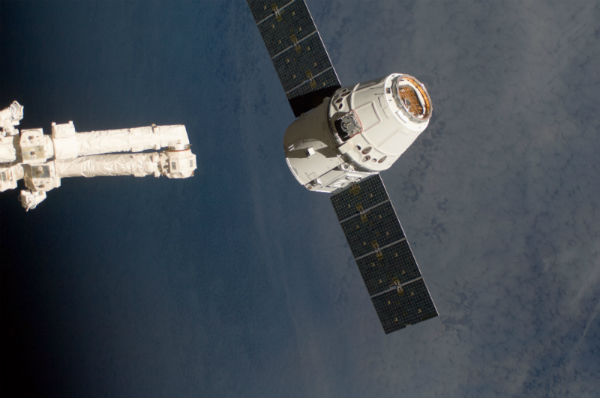
The SpaceX Dragon commercial cargo craft, as it is about to be grappled by the Canadarm2 robotic arm at the International Space Station in May 2012.
In preparation for a summer 2014 test, NASA partner Space Exploration Technologies (SpaceX) recently laid out its plan to demonstrate the Dragon spacecraft’s ability to carry astronauts to safety in the event of an in-flight emergency.
This review of the in-flight abort test plan provided an assessment of the Dragon’s SuperDraco engines, the software that would issue the abort command, and the interface between the Dragon spacecraft and the Falcon 9 rocket on which the spacecraft will be launched.
“It’s critical to have a launch abort system in which NASA and SpaceX can have confidence,” said Phil McAlister, director of Commercial Spaceflight Development at NASA Headquarters in Washington. “When you put humans aboard, safety and reliability are paramount and this review and the upcoming tests will help prove their space transportation system is on the right track.”
Experts from NASA and the Federal Aviation Administration attended the review of the in-flight abort test plan Sept. 17 at SpaceX headquarters in Hawthorne, Calif. Attendees also had the opportunity to view the Dragon test spacecraft, which is being manufactured for an upcoming pad abort test and, potentially, the in-flight abort test.
“With NASA’s support, SpaceX continues to implement the necessary modifications to equip Dragon to fly crew,” said Garrett Reisman, commercial crew project manager at SpaceX. “SpaceX and NASA believe in rigorous flight testing and we are looking forward to putting our SuperDraco launch abort system through these critical tests, starting with the pad abort test in the spring and followed by the in-flight abort test in the summer.”
The in-flight abort test will take place along Florida’s space coast. During the test, a Dragon spacecraft will launch on a standard Falcon 9 rocket and an abort command will be issued approximately 73 seconds into the flight. At that point, the spacecraft will be flying through the area of maximum dynamic pressure, or Max Q, where the combination of air pressure and speed will cause maximal strain on the spacecraft.
Dragon will be outfitted with about 270 special sensors to measure a wide variety of stresses and acceleration effects on the spacecraft. An instrumented mannequin, similar to a crash test dummy, also will be inside. The spacecraft’s parachutes will deploy for a splashdown in the Atlantic, where a ship will be pre-positioned for simulated rescue operations. The test spacecraft will be returned to Port Canaveral by barge so data can be retrieved and incorporated into the system’s design.
SpaceX is one of three companies working under NASA’s Commercial Crew Integrated Capability (CCiCap) initiative to develop spaceflight capabilities that eventually could provide launch services to transport NASA astronauts to the International Space Station from U.S. soil.
This review was the eighth milestone for SpaceX under CCiCap. The company is on track to complete all 15 of its CCiCap milestones by the summer of 2014. All of NASA’s industry partners, including SpaceX, continue to meet their established milestones in developing commercial crew transportation capabilities.
For more information about NASA’s Commercial Crew Program and its aerospace industry partners, visit:
https://www.nasa.gov/commercialcrew
-end-
Trent J. Perrotto
Headquarters, Washington
202-358-1100
trent.j.perrotto@nasa.gov
Stephanie Covey
Kennedy Space Center, Fla.
321-867-2468
stephanie.a.covey@nasa.gov
Emily Shanklin
SpaceX, Hawthorne, Calif.
310-363-6733
media@spacex.com

























